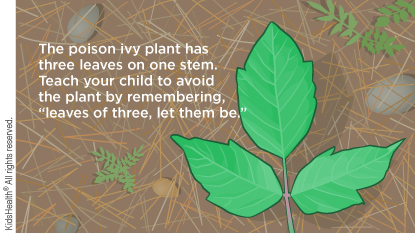Poison ivy is a plant that can cause an itchy rash when touched. The rash is caused by an allergic response to the oil on poison ivy (called urushiol). Someone can touch the oil on the poison ivy plant, on someone else's skin, on hard surfaces like gardening tools and sports gear, or on pets' fur. The rash can start within hours of touching the oil or as long as 5 days later.
The rash is red, very itchy, and has blisters. It usually gets worse over the first few days to a week then clears up by about 3 weeks.
Although the rash from poison ivy will get better on its own, treatments can help with itchiness and discomfort.

Your child has trouble breathing or swallowing.

What can help protect kids from poison ivy? It can help to:
- Show family members what poison ivy looks like so they can stay away from it. Tell them to remember "leaves of three, let them be."
- Wear long sleeves, long pants, and closed-toe shoes when in wooded areas.
- Wear thick gloves when gardening or working outside.
- Use a barrier cream that contains bentoquatam (available without a prescription) when going to an area that likely has poison ivy. The cream helps prevent the poison ivy oil from touching the skin. Check with your health care provider before using bentoquatam products and follow the label directions.
- If someone in your family might have touched poison ivy, take these steps as soon as you can (preferably within an hour):
- Wash their skin using a washcloth with regular or dish soap and water.
- Scrub under their nails with a nail brush and soap and water.
- Wash the clothes they were wearing with detergent.
- Clean any outside gear, sports equipment, and shoes that touched the plant.
- If your dog may have touched poison ivy, bathe it with pet shampoo as soon as you can.
- Avoid burning poison ivy plants because the oil in them can spread in the smoke and be inhaled.
Is poison ivy contagious? The rash and fluid from the blisters can't spread poison ivy. But the rash from poison ivy can spread from the oil under the nails and on skin, clothing, hard surfaces, or pets.




